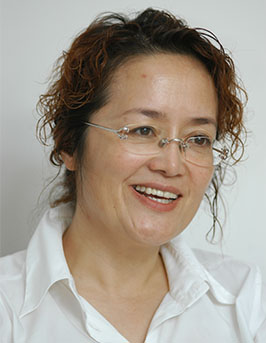
Qin chuan
Name:Qin chuan
Subject:Pathology and pathophysiology
Tel:010-67779915
Email:qinchuan@pumc.edu.cn
Address:No.5, Panjiayuan Nanli, Chaoyang District, Beijing
- Resume Introduction
- The research field
- Social Positions
- Awards and Honors
- Research Projects
- Representative works
Qinchuan, a female MD and researcher, is the Director of the Institute of Laboratory Animal Sciences, Chinese Academy of Medical Sciences, expert of Medical Sciences and expert of special allowance by State Council. She received her doctorate in pathology and pathophysiology in 2006. She is mainly engaged in experimental pathology development, and has established a series of neurodegenerative disease models, China's largest resource bank of animal models of human diseases, Comparative Medical Technology Platform and National Platform for Animal Model of Infectious Diseases. In addition, she has been worked on the development of animal models of human diseases, the research of disease mechanism and the application of drug development models for a long time, and created the discipline of medical comparative medicine. The relevant representative research results were published in the journals of Nature Medcine, Nature Microbial, and Nature Communication, respectively. She published 283 papers as the first or corresponding author, 110 SCI papers of Nature Microbiol, Nature Med, and the like included, which were cited for 1595 times. She has obtained 10 authorized invention patents, and she was the editor-in-chief of 17 monographs and 5 textbooks, 3 industry training materials, training 81 graduate students and postdoctoral. She also leaded establishment of 152 standards and won 18 awards of science and technology (including the First National Innovation Top Prize, the third prize of National Prize for Progress in Science and Technology), achieving the honors of the National "March 8th" Red Banner, National Excellent Science and Technology Workers, etc.
Comparative medicine, emerging and reemerging infectious diseases, neurodegenerative diseases
Chairman of Chinese Association for Laboratory Animal Sciences; Vice President of Asian League for Laboratory Animal Sciences(AFLAS); Director of Personnel Training Department of International Council for Laboratory Animal Sciences; Chairman of the National Technical Committee for Standardization of Laboratory Animal;
Editor-in-chief of Chinese Journal of Laboratory Animal, Chinese Journal of Comparative Medicine, Animal Model and Experimental Medicine; Director of the National Pathology Quality Testing Center for Laboratory Animal, Visiting Professor of Department of Medicine, Keio University, Japan; laboratory animal pathologist of the Ministry of Science and Technology; member of China Toxicology Society;
Member of Chinese Committee of the International Alzheimer's Association;
evaluation experts of National 863, small and medium-sized innovation fund and other projects
In 2003, participated in "Establishment of SARS Infected Animal Model" as the project leader and won the Advanced Individual Award of Beijing United Front System against SARS issued by Beijing United Front Work Department.
"Establishment and Application of Transgenic neurodegenerative Disease animal Model" won the third prize of Chinese Medical Science Award in 2003 and 2015, respectively.
In 2006, "Clinical and Basic Research of Severe Acute Respiratory Syndrome (SARS)" won the second prize of National Scientific and Technological Achievements.
In 2012, "Establishment and Application of AIDS Primate Model Research System" and "Establishment of Animal Biosafety Laboratory Support Technology Platform" were both awarded the first prize of Science and Technology Award of Chinese Society of Laboratory Animals.
In 2016, "Establishment and Application of Animal Model Database for Major Infectious Diseases" won the second prize of Science and Technology Progress Award.
In 2017, she won the National Innovation Award.
In 2018, she won the National "March 8th" Red Banner Model and the Most Beautiful Scientific and Technological Worker Award.
At present, she mainly undertakes the National Natural Science Fund project on "the research on the way of human enterovirus type 71 synaptic invading the cells of the nervous system", major collaborative innovation of the Medicine and Health Science and Technology Innovation Project, Chinese Academy of Medical Sciences, "creation on animal models resources of human diseases ", a key project of Beijing Municipal Natural Science Foundation, "therapy exploration on autologous fat stem cells of cynomolgus monkey Parkinson's animal models", central basic scientific research business expenses "establishment on the system of medical analysis technology for human disease animal model comparison" , etc.
1. Chen Z, Wang J, Bao L, Guo L, Zhang W, Xue Y, Zhou H, Xiao Y, Wang J, Wu F, Deng Y*, Qin C*, Jin Q*. Human monoclonal antibodies targeting the haemagglutinin glycoprotein can neutralize H7N9 influenza virus. Nat Commun. 2015;6:6714.
2. Liu B, Zhang X, Deng W, Liu J, Li H, Wen M, Bao L, Qu J, Liu Y, Li F, An Y, Qin C*, Cao B*, Wang C*. Severe influenza A(H1N1)pdm09 infection induces thymic atrophy through activating innate CD8(+)CD44(hi) T cells by upregulating IFN-γ. Cell Death Differ. 2014;5:e1440.
3. Liu Y, Snedecor ER, Choi YJ, Yang N, Zhang X, Xu Y, Han Y, Jones EC, Shroyer KR, Clark RA, Zhang L, Qin C*, Chen J*. Gorab Is Required for Dermal Condensate Cells to Respond to Hedgehog Signals during Hair Follicle Morphogenesis. J Invest Dermatol. 2016;136(2):378-86.
4. Tang J, Sun M, Shi G, Xu Y, Han Y, Li X, Dong W, Zhan L, Qin C*. Toll-Like Receptor 8 Agonist Strengthens the Protective Efficacy of ESAT-6 Immunization to Mycobacterium tuberculosis Infection Front Immunol. 2018;8:1972.
5. Yao Y, Bao L, Deng W, Xu L, Li F, Lv Q, Yu P, Chen T, Xu Y, Zhu H, Yuan J, Gu S, Wei Q, Chen H, Yuen KY, Qin C*. An animal model of MERS produced by infection of rhesus macaques with MERS coronavirus. J Infect Dis. 2014; 209(2): 236-42.
6. Chen W, Qin C*. General hallmarks of microRNAs in brain evolution and development. RNA Biol. 2015;12(7):701-8.
7. Song N, Zhang L, Chen W, Zhu H, Deng W, Han Y, Guo J, Qin C*. Cyanidin 3-O-β-glucopyranoside activates peroxisome proliferator-activated receptor-γ and alleviates cognitive impairment in the APPswe/PS1ΔE9 mouse model. Biochim Biophys Acta. 2016; 0925-4439(16)30133-8.

 WeChat
WeChat